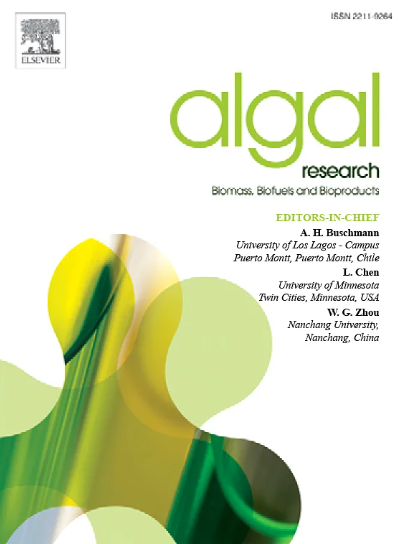Feasibility of using freshwater microalgae to remove triclosan from aqueous media
IF 4.6
2区 生物学
Q1 BIOTECHNOLOGY & APPLIED MICROBIOLOGY
Algal Research-Biomass Biofuels and Bioproducts
Pub Date : 2025-03-13
DOI:10.1016/j.algal.2025.104001
引用次数: 0
Abstract
Triclosan, [5-chloro-2-(2,4-dicholophenoxy)phenol] (TCS), a broad-spectrum antimicrobial agent found in many personal care products, has raised concerns due to its presence in the environment. TCS has been associated to harmful effects, including oxidative damage in golfish cells, increased lipid peroxidation in clams, and disruption of the hypothalamic-pituitary-gonadal axis in Catla fish, and its potential contribution to antimicrobial resistance. This study evaluates the feasibility of using two freshwater microalgae species to remove TCS from aqueous media by 1) determining the toxicity of TCS on algal cultures, 2) evaluating their potential to remove TCS, and 3) identifying the TCS degradation kinetics. The toxicity test assessed various concentrations of TCS (0.06, 0.10, 0.20, 0.30, 1 mg L−1) on Chlorella vulgaris and Scenedesmus obliquus growth. Results showed that C. vulgaris was entirely inhibited by concentrations exceeding 0.10 mg L−1. In comparison, S. obliquus tolerated up to 0.30 mg L−1 after six days of lag phase, but 1 mg L−1 was toxic for both species. The removal efficiency achieved by S. obliquus was between 79 % and 94 % across all concentrations tested, while C. vulgaris achieved 70–95 % removal only in concentrations lower than 0.10 mg L−1. The degradation kinetics revealed that the TCS half-life in wastewater was 1.3 days when S. obliquus was present, highlighting its potential to enhance pollutant removal. This study provides insights into the use of S. obliquus for removing contaminants from natural environments, contributing to understanding TCS dynamics in ecosystems with the presence of microalgae.
求助全文
约1分钟内获得全文
求助全文
来源期刊

Algal Research-Biomass Biofuels and Bioproducts
BIOTECHNOLOGY & APPLIED MICROBIOLOGY-
CiteScore
9.40
自引率
7.80%
发文量
332
期刊介绍:
Algal Research is an international phycology journal covering all areas of emerging technologies in algae biology, biomass production, cultivation, harvesting, extraction, bioproducts, biorefinery, engineering, and econometrics. Algae is defined to include cyanobacteria, microalgae, and protists and symbionts of interest in biotechnology. The journal publishes original research and reviews for the following scope: algal biology, including but not exclusive to: phylogeny, biodiversity, molecular traits, metabolic regulation, and genetic engineering, algal cultivation, e.g. phototrophic systems, heterotrophic systems, and mixotrophic systems, algal harvesting and extraction systems, biotechnology to convert algal biomass and components into biofuels and bioproducts, e.g., nutraceuticals, pharmaceuticals, animal feed, plastics, etc. algal products and their economic assessment
 求助内容:
求助内容: 应助结果提醒方式:
应助结果提醒方式:


